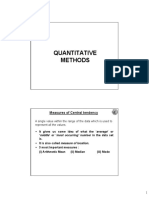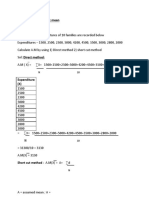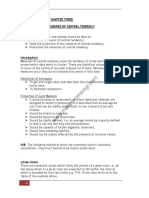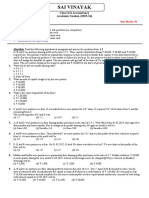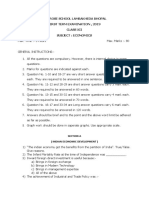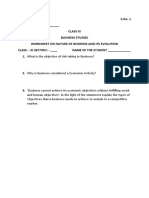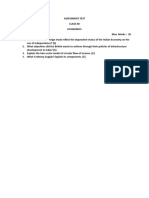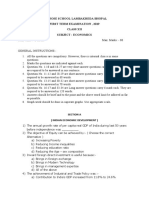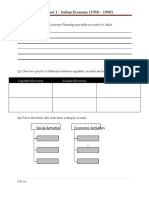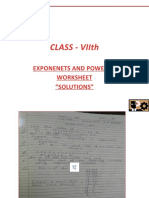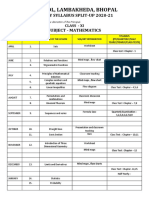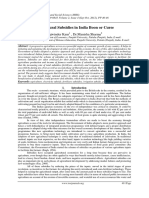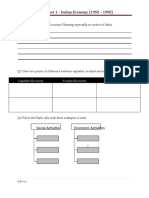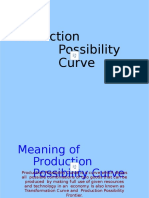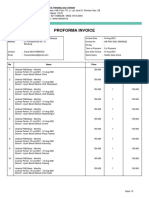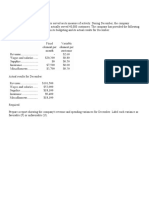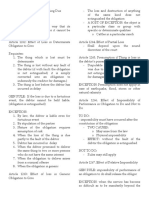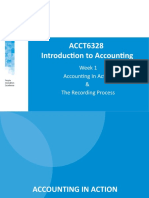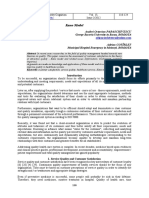Solution
PERIODIC TEST II
Class 11 - Economics
Section A
1.
(d) 90
Explanation:
N = 5 , Values of all observations = 72 + 86 + 92 + 63 + 77 = 390 i.e. 90 (6 × 80) number less all the observations of Bob’s
score.
Bob need to score in 6th Test = 90
So that his Sum of the values of all 6 test = 480
2.
(c) The simple average of the two middle values
Explanation:
In case of even number of items , median = average of the two middle items. After arranging the data in ascending order, We
have to apply the formula
n+1
M edian = size of [ ]th item
2
for eg. if there are 6 items
then median = size of (6+1)/2 th item = 7/2th item = size of 3.5 th item.
then we have to take the simple average of the 3rd and 4th item as median is size of 3.5 th item
OR
(b) Median
Explanation:
Median can be calculated even when a distribution has open ended classes. The median is not affected by extremely high or
low values so it is a measure of central tendency mostly needed in a markedly skewed distribution.
3.
(c) ₹ 250
Explanation:
₹ 250
change in variable Cost
Marginal cost =
change in Quantity
3,000−2,500
Marginal cost = 10−8
= 250
4.
(b) AFC can never be zero as TFC can never be zero
Explanation:
There is always an element of TFC even at zero kevel of output. Because of this reason AFC can never be zero and though it
kies close to the X axus it can never touch the X axis.
5.
(b) ₹ 770
Explanation:
₹ 770
1/5
� 6.
(c) ₹ 15
Explanation:
₹ 15
change in T otal revenue 300−270
Marginal revenue = = 10−8
=
30
2
= 15
change in quantity
7. (a) Both A and R are true and R is the correct explanation of A.
Explanation:
Both A and R are true and R is the correct explanation of A.
OR
(b) Both A and R are true but R is not the correct explanation of A.
Explanation:
Both A and R are true but R is not the correct explanation of A.
8.
(c) A is true but R is false.
Explanation:
A is true but R is false.
9. (a) Both A and R are true and R is the correct explanation of A.
Explanation:
Both A and R are true and R is the correct explanation of A.
10. (a) MC curve cuts AC curve at its lowest point.
Explanation:
MC curve cuts the AC curve from below at the minimum (or lowest) point of SAC.
OR
(b) AC = AFC + AVC
Explanation:
AC = AFC + AVC is true.
Section B
11. To find unknown frequency subtract the sum of known frequencies from the sum of total frequencies. Here it is given that the sum
of frequencies is 50.
Σf = 50
and the known frequencies are 5,7,10,8 and 6.
∵ Sum of known frequency= 5+7+10+8+6=36
∴ Unknown Frequency = Total Frequency-Sum of Known Frequencies
=50 - 36=14.
Therefore, the missing frequency is 14.
12. i. When TR curve is a positively sloped straight line (passing through the origin), MR curve will be a horizontal straight line
parallel to X-axis.
ii. When TR curve is a horizontal line, MR curve will touch X-axis, i.e., MR will be zero (0). Because addition to TR (which is
MR) will be zero in this case.
Section C
13. Income (in Rs.) Number of Families (f) Mid-Value (m) dm(m-A) (A=110) (c=10) fd'm
′ dm
d m =
c
75-85 10 80 -30 -3 -30 -100
85-95 25 90 -20 -2 -50
2/5
� 95-105 20 100 -10 -1 -20
105-115 25 110 0 0 0 0
115-125 10 120 +10 +1 +10
125-135 20 130 +20 +2 +40
195
135-145 15 140 +30 +3 +45
145-155 25 150 +40 +4 +100
′
Σf = 150 Σf d m = +95
Here,
A = 110
C = 10
Σf = 150
′
Σf d m = +95
Now,
′
¯¯¯
¯ Σf d m
X = A+ × c
Σf
95
= 110 + × 10 = 110 + 6.33 = Rs.116.33
150
¯¯¯
¯
∴ X = Rs.116.33
Therefore,the arithmetic mean of daily income of 150 families is Rs. 116.33
14. The table mentioned in the question can be calculated with the help of the formulas mentioned in the table as follows:
(Rs.) AVC (Rs.) TC (Rs.) MC (Rs.) TVC TFC
Output
(TVC× Q) TVC + TFC (TCn - TCn-1) T V C = ΣM C (Rs.)
0 - 24 - - 24
1 20 44 20 20 24
2 15 54 10 30 24
3 15 69 15 45 24
4 16 88 19 64 24
15. Revenue Schedule
Output ((units) Price TR MR
4 9 36 0
5 8 40 4
6 7 42 2
7 6 42 0
8 5 40 -2
Formulae used ,
Price= ,TR=ΣMR or AR×Q
TR
TR
AR =
Q
or P= AR, MRn = TRn-TRn-1
OR
TR
Units Sold (Q) MR (₹) TR = ∑MR AR =
Q
(₹)
1 14 14 + 0 = 14 14
2 10 14 + 10 = 24 12
3 7 24 + 7 = 31 10.33
4 5 31 + 5 = 36 9
3/5
� 5 0 36 + 0 = 36 7.2
6 -3 36 – 3 = 33 5.5
7 -5 33 – 5 = 28 4
Section D
16. Let the frequencies be f1 for a class interval of 40-50 and f2 for class interval of 60-70
The cumulative frequency for the given data is calculated as follows:
Wages (in Rs. (X) Number of Workers(f) Cumulative Frequency (cf)
20-30 60 60
30-40 60 120
40-50 f1 120+f1
50-60 200 320+f1
60-70 f2 320+f1+f2
70-80 285 605+f1+f2
n=Σ f=1000
Here, n=1000
Sum of
Median= 56 (given) frequencies=1000
(given)
∴ m = Size of (
n
2
) th item = (
1000
2
) th item
Here, f1 and f2 are unknown so we cannot find the cf equal of just greater than 500 but ⇒ 60 + 60 f1 + 200
Median= 56 is given and it lies in the interval 50-60 so median class is 50-60. + f2 + 285=1000
∴ l1=50, c f=120 + f1, f=200, c=10 ⇒ 605 + f1 + f2
n
Now, M = l +
2
−cf
× c
=1000
1
f
⇒ f1 + f2 =1000 -
500−120−f1
⇒ 56 = 50 + ( ) × 10
200
605
380−f1
⇒ 56 = 50 + (
20
) f1 + f2 =395
380−f1 380−f1
⇒ 56 − 50 =
20
⇒ 6 =
20
∴ f2 =395 - 260
⇒ 380 - f1=6 × 20 ⇒ f1=380 - 120 =135 [∵ f 1 = 260]
⇒ f1=260
Hence, frequency of 40-50 class=260; frequency of 60-70 class =135.
OR
Median may be defined a the middle value in the data set when its elements are arranged in a sequential order, that is, either in
ascending or descending order of magnitude. It concentrates on the middle or centre of a distribution.
According to Connor, "The median is that value of the variable which divides the group into two equal parts, one part comprising
all parts greater, and the other values less than median."
According to Horace Secrist, "Median of a series is the value of the item actual or estimated when a series is arranged in order of
magnitude which divides the distribution into two parts."
According to Croxton and Cowden, "the median is generally defined as the value which divides the distribution so that an equal
number of items is on either side of it."
Merits:
1. The median is useful in case of frequency distribution with open-end classes.
2. The median is recommended if distribution has unequal classes.
3. Extreme values do not affect the median as strongly as they affect the mean.
4. It is the most appropriate average in dealing with qualitative data.
4/5
� 5. The value of median can be determined graphically where as the value of mean can not be determined graphically.
6. It is easy to calculate and understand.
Demerits:
1. For calculating median it is necessary to arrange the data, where as other averages do not need arrangement.
2. Since it is a positional average its value is not determined by all the observations in the series.
3. Median is not capable for further algebraic calculations.
4. The sampling stability of the median is less as compared to mean.
17. MC=Marginal Cost ,AVC= Average Variable Cost
Cost Schedule
Output ( (units) (MC)(Rs) (AVC) (Rs) (AFC) (Rs) (AC) (Rs) (TVC)( (Rs)
1 50 50 90 140 50
2 40 45 45 90 90
3 45 45 30 75 135
4 57 48 22.5 70.5 192
5 68 52 18 70 260
OR
Cost Schedule
Output (Q) Total Cost (TC) Average Fixed Cost (AFC) Average Variable Cost (AVC) Marginal Cost (MC)
(units) (Rs) (Rs) (Rs) (Rs)
0 36 0 0 0
1 54 36 18 18
2 68 18 16 14
3 84 12 16 16
4 108 9 18 24
5/5

